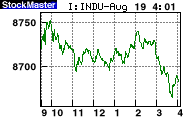
We are all familiar with decimals. They are in our lives on a daily basis. For instance, if you are a baseball fan you might see that your favorite player is hitting .286 this season. That means that 28% of the time he gets a base hit. It also means that he gets a hit 2 out of every 7 times at-bat.
Let's refresh our memory on how to get decimals. When we have the fraction 1/2, we know that that is one-half, or 50%, or 0.5. How do we get that decimal? Simple! We take the denominator 2 and divide into the numerator 1. That gives us 0.5. You can use a calculator, such as one that comes with your computer, or you can do the division on a piece of paper. Can you find what decimal 3/8 equals?
If you got 0.375, you're right! Notice that if the numerator is larger than the denominator, you'll have numbers greater than 0 on the left of the decimal. For instance, 5/4 equals 1.25. You'll notice if you reduce 5/4 to 1 1/4, you get 1 + 1/4 = 1 + 0.25 = 1.25.
We use decimals when we have our temperature taken. Average temperature for a human is 98.6 degrees Farenheit. You're temperature might be high or low if we rounded to 98 or 99 degrees.

One way we have in America to make money is through the stock exchange. If you look in the back of the business section of the newspaper, you'll see a long list of strange abbreviations with a lot of numbers next to them.
What does it all mean? Well, the list of names is the different companies that sell stock. You can buy stock, with the help of a stockbroker, and then you can check every day to see if your stock's value went up or down.
You can find information on stocks in the newspaper or on the World Wide Web. Let's take a look at one such stock :
Notice that the company is Pepsi-Cola, owner of Pepsi and all related drinks, Taco Bell, Pizza Hut, and other restaurants. You are given the last day the report was given (below is a sample from March 19, 1996). The next number is the close, which means that that is how much 1 share of Pepsi-Cola stock would cost if you bought it at that moment. On March 19, 1996, the stock cost $63 for one share.
The next number is how much the stock went up or down from the previous day's close. You'll notice below that Pepsi-Cola went up 0.625, or 5/8. How much did it cost yesterday? See if you can figure it out. Check your *answer at the bottom of this page.
The last number tells you what percentage the stock went up or down. On March 19, the stock went up 1%, which is (0.63000/0.625). We will divide with decimals at a later date.
(Try this yourself)
When we multiply with decimals, we do the same thing, only there is one change. We count up the number of digits to the right of the decimals and then put that many digits to the left of the decimal in our answer. For example:
Do you see that we had two digits to the left of the decimal in the first number, no digits to the left in the second number, and two digits to the left in our answer? What about
Do you get it?